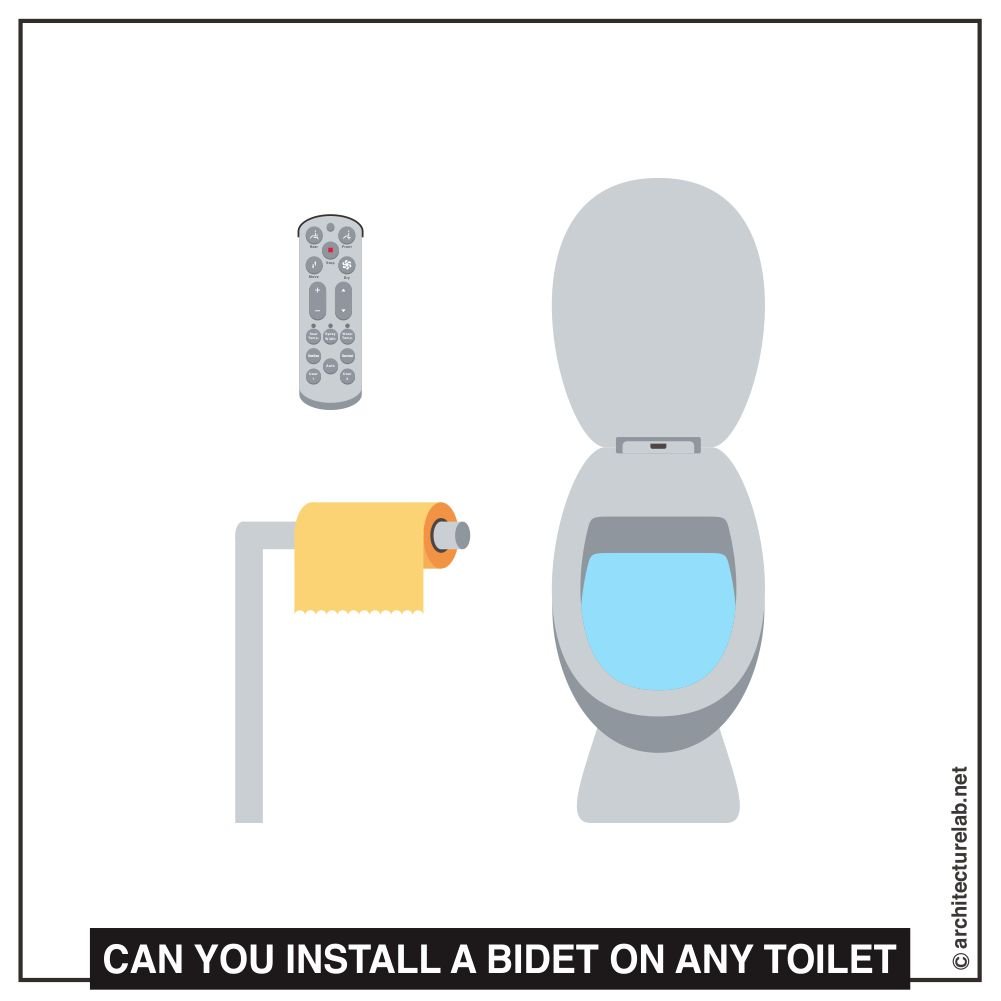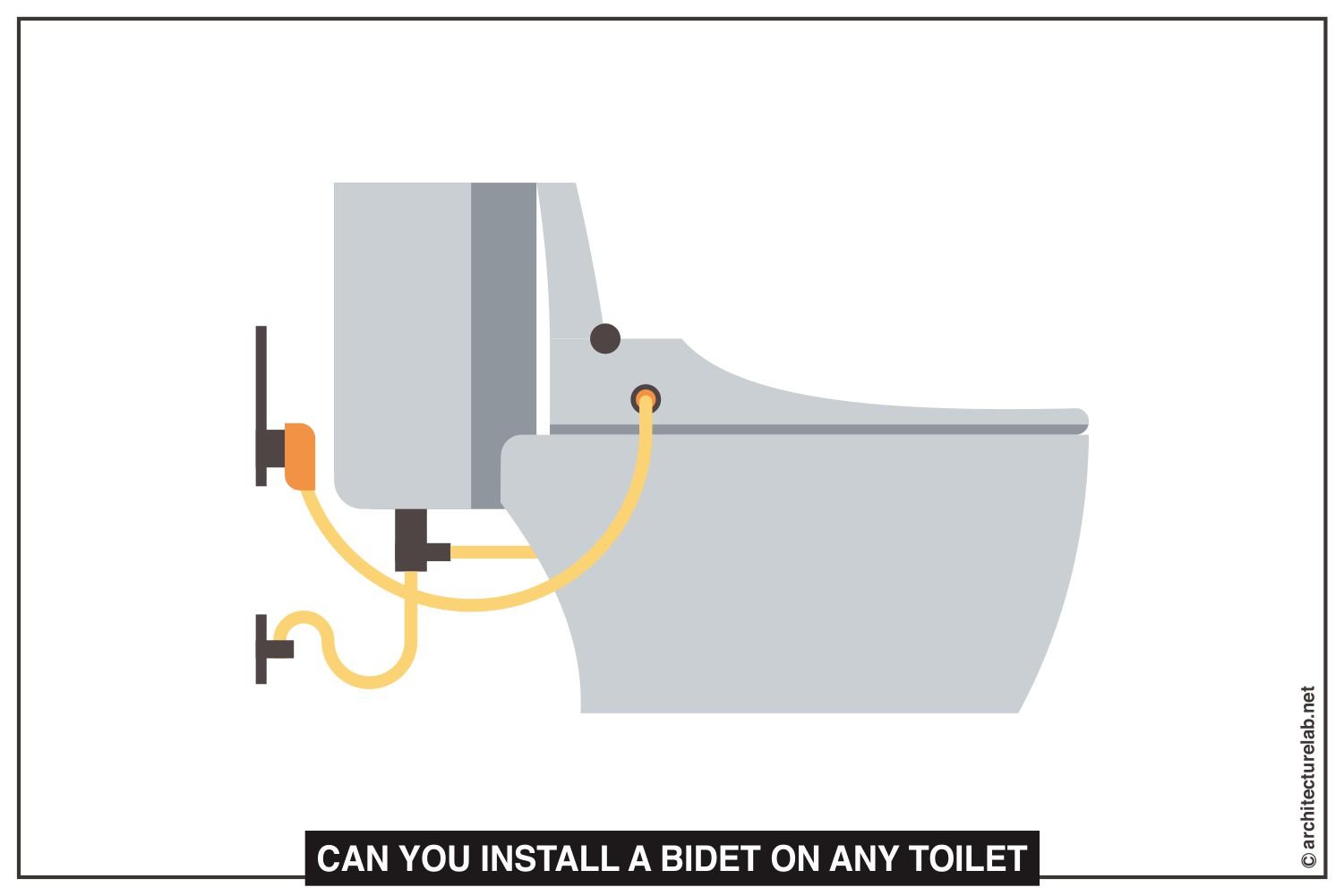Bidets allow better hygiene, reduce toilet paper expenditure, and are better for the environment.
Because of these reasons, the popularity of bidets is increasing rapidly in the United States. And more and more people are looking to get them installed. But getting a bidet installed is not so simple, as toilets can vary in their construction and design.
This guide aims to help you know whether installing a bidet on any toilet is possible.
Can You Install A Bidet On Any Toilet?

It is possible to install bidets on most types of toilets, but how straightforward the process will be can vary significantly between different toilets. While installing a bidet on an existing toilet seat is generally quite simple, sometimes you may need additional parts, or the bathroom may need to be slightly altered.
The construction of a bidet can also affect installation, and while ceramic and porcelain bidets are the most common, you can even find stainless steel ones. Additionally, installing a bidet can be complicated in the absence of a shutoff valve or if the toilet features an unusual design. In such situations, there are workarounds that need to be adopted to ensure that the bidet gets installed properly.
So, it is important to consider how much work the process will involve and whether it will be worth it when getting a bidet installed. Another factor to keep in mind is that the majority of bidet attachments are designed to be compatible with most types of toilet seats. But some are designed only to fit a specific design.
So, the installation will require finding a bidet that is suitable for your toilet seat.
Bidet Installation On Different Types Of Toilets
Two-Piece Toilets
A two-piece toilet is one where the toilet bowl and the toilet seat are built separately and attached afterward. The toilet tank is fitted to the back of the bowl, and the fixture relies on gravity for operation, like standard flush tank commodes.
However, sometimes the tank may have a pump that uses pressure to release water to flush away the waste from the bowl, but this is not very common. Flush tank toilets can also be found in one-piece designs, but installing a bidet is much easier than two-piece ones. These are compatible with most bidets, except non-electric warm water options.
Several reasons make two-piece toilets most suitable for bidet installations, such as easy access to the fill valve located underneath the toilet tank, standard design, dimensions, etc. Additionally, unlike a skirted toilet, there are no hidden parts that can make installation challenging.
The only downside is that a larger number of bidets are available for two-piece toilets with elongated bowls than for round ones. But as long as the bolt-hole widths are the same, they can be used interchangeably, though it can affect their appearance.
Traditional One-Piece Toilets
In the case of a one-piece toilet, the toilet comprises a single unit that includes the toilet seat and bowl. This design means that the toilet has few crevices and lines and has a modern, minimalistic appearance. Since these types of toilets are available in various designs, it is important to note that those with traditional designs are best for bidet installations.
The toilet’s fill valve is easily accessible in these toilets, even if they have a skirted design, and additional components, like adapters, conversion kits, and extension hoses, are easily available. However, issues may sometimes arise if the mounting hardware is incompatible with the toilet.
For instance, the toilet bowl mounting holes may not be accessible easily, making it difficult to replace existing toilet seat bolts with new ones. In such instances, top mounting hardware with top mounting bolts will be required to complete the installation.
Other Types Of Toilets
Tankless Toilets
Tankless toilets do not need gravity to function and do not have a toilet tank. Instead, they have a handle that can be used to flush away the waste. There is also no need for a T-connector due to the lack of any external water connection. Instead, the flush valve of a tankless toilet gets water directly from the concealed plumbing.
For installing bidets in such toilets, the bathroom should be designed and constructed in a specific way. Both the toilet and the sink need to be on the same side of the bathroom and close to each other. If there is any vanity cabinet in between, it may need to be removed.
Such workaround installation methods only work for regular handheld bidet sprayers and bidet attachments, not for electric options.
Wall-Hung Toilets
Wall-hung toilets may appear similar to tankless ones, but they have a toilet tank or cistern concealed behind the bathroom wall. Because of this, the bidet installation process for such toilets can be equally complicated. A shutoff valve may need to be installed near the toilet for this purpose.
Getting such a valve installed will make the installation of electronic bidet toilet seats possible. Otherwise, separate bidet seat attachments and handheld sprayers can be used.
Unconventional One-Piece Toilets
One-piece toilets are generally common in modern bathrooms due to their minimalistic appearance and are available in various designs and styles. However, as mentioned above, while installing a bidet is easy in the case of those with traditional designs, the same cannot be said for unconventional ones.
There are several types of problems that can make such installations complicated. For instance, the gap between the bolt holes should ideally be around 5.5 inches but can be much larger. A larger width will make bidet installations difficult as the mounting bracket with bidets is usually adjustable only to a limited extent.
Other aspects, such as the tank sloping down to connect with the seat, large edges or corners, or rounded areas behind the sitting area, can also affect bidet installations. Alternatively, the shape of the toilet seat itself might be an obstacle. One-piece toilets are also generally skirted toilets, which prevent access to the fill valve, or they may be located too close to the bathroom wall.
Alternative Solutions
In situations where it may be impossible to get a bidet toilet seat attached to your existing toilet seat, a standalone bidet attachment might be an ideal solution. Compared to a bidet toilet seat, standalone bidets come with a few additional features.
These may include an adjustable nozzle, adjustable water pressure, inbuilt water heating and warm water spray, warm air dryer, heated seats, remote control, etc. Also, unlike a bidet toilet seat, you can get complete cleanliness without relying on toilet paper with a standalone bidet.
However, installing a separate bidet shower may require additional plumbing, and it will need to be connected to an electrical outlet. Also, it needs additional space, which may require a certain level of renovation in the bathroom.
Another alternative would be a toilet-bidet combo, which is a toilet that has a built-in bidet and can be connected to the drinking water supply like a regular toilet. It offers the benefits of a bidet without needing a separate installation, such as better health and hygiene, and is also environmentally friendly. But it can be quite costly, which is not very common.
Tip
When deciding whether to get a handheld bidet sprayer, standalone bidet, or bidet seat installed, consider your requirements. Handheld sprayers allow easier targeting of the area to be cleaned, while most bidet seats can be installed on existing toilets. Standalone bidets provide more effective cleaning but require more space.
Is it easier to get a new bidet toilet seat installed instead of a standalone attachment?
Most bidet toilet seats are easier to install than a freestanding bidet since they are mounted directly to a toilet. In contrast, a standalone bidet attachment is a separate fixture that requires additional plumbing.
Can you install a round bidet seat on elongated toilets?
The back end of most bidet toilet seats is similar, while the length of the seat and the lid is different. So, it may be possible to install round bidet toilet seats on elongated toilets, though it may not provide the best experience.
Why is installing handheld bidets easier than electric ones?
Electric bidets need an electrical outlet nearby for operation, which is not the case with handheld sprayers. Also, most bidet manufacturers design handheld bidets to ensure easy installation without requiring the use of any special tools.
What are some features to consider when getting a bidet installed?
Since their origin in France, bidets have evolved to offer a wide range of features. Some features worth considering include an air freshener, a clothes dryer or a compressed air dryer, a nightlight, slow-close seats, temperature control, and more.
How much time does it take to install a bidet toilet seat?
It takes around 30 minutes to get a bidet toilet seat installation completed, though this will depend on the type of toilet already present. Installing a bidet seat on a standard toilet with a two-piece design will generally be much quicker than on modern one-piece ones with hidden parts.
Conclusion
Whether it is handheld sprayers or full-fledged bidet seats, most options can be installed on existing toilets of various types and designs. The vital thing to remember here is that different toilets require different types of bidets. Some may only support non-electric handheld options, while others may support bidet seats.
If you’re unsure about whether your toilet supports a bidet, it is best to consult a licensed plumber for the purpose. A plumber can not only help determine whether a bidet seat can be installed but also recommend the most suitable options that can provide the best bathroom experience.



